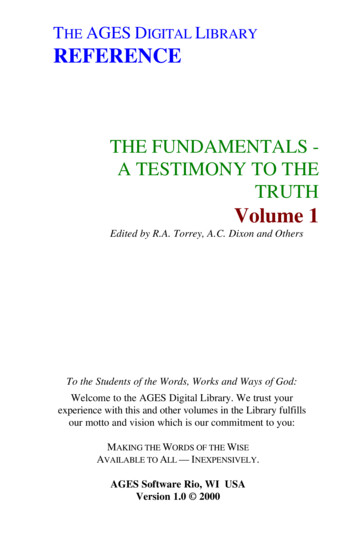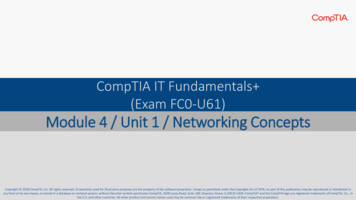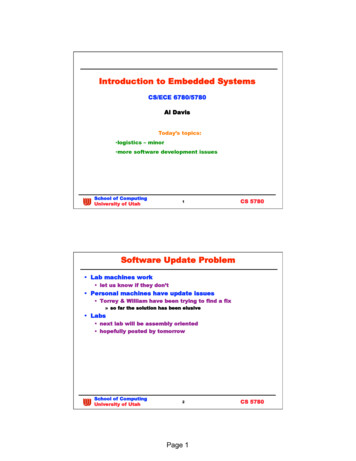
Transcription
THE AGES DIGITAL LIBRARYREFERENCETHE FUNDAMENTALS A TESTIMONY TO THETRUTHVolume 1Edited by R.A. Torrey, A.C. Dixon and OthersTo the Students of the Words, Works and Ways of God:Welcome to the AGES Digital Library. We trust yourexperience with this and other volumes in the Library fulfillsour motto and vision which is our commitment to you:MAKING THE WORDS OF THE WISEAVAILABLE TO ALL — INEXPENSIVELY.AGES Software Rio, WI USAVersion 1.0 2000
2THE FUNDAMENTALSA TESTIMONY TO THE TRUTH“To the Law and to the Testimony” 230820 Isaiah 8:20EDITED BY R. A. TORREY, A. C. DIXON AND OTHERSVOLUME 1
3CONTENTSChapter 1. THE HISTORY OF THE HIGHER CRITICISM — By CanonDyson Hague, M. A., Rector of the Memorial Church, London,Ontario. Lecturer in Liturgics and Ecclesiology, Wycliffe College,Toronto, Canada. Examining Chaplain to the Bishop of Huron.Chapter 2. THE MOSAIC AUTHORSHIP OF THE PENTATEUCH — ByProfessor George Frederick Wright, D. D., L. L. D., OberlinCollege, Oberlin, Ohio.Chapter 3. By Professor Franklin Johnson, D. D., L. L. D.Chapter 4. THE BIBLE AND MODERN CRITICISM — By F. Bettex, D. D.,Professor Emeritus, Stuttgart, Germany. Translated from theoriginal German, by David Heagle, D. D.Chapter 5. THE HOLY SCRIPTURES AND MODERN NEGATIONS — ByProfessor James Orr, D. D., United Free Church College, Glasgow,Scotland.Chapter 6. CHRIST AND CRITICISM — By Sir Robert Anderson, K. C.B., L. L. D., Author of “The Bible and Modern Criticism,” etc.,London, England.Chapter 7. OLD TESTAMENT CRITICISM AND NEW TESTAMENTCHRISTIANITY — By Professor W. H. Griffith Thomas, WycliffeCollege, Toronto, Canada.Chapter 8. THE TABERNACLE IN THE WILDERNESS: DID IT EXIST? —A Question Involving the Truth or Falsity of the Entire HigherCritic Theory, by David Heagle, Ph. D., D. D., Professor ofTheology and Ethics, Ewing College; Translator “BremenLectures;” Author of “Moral Education;” “That Blessed Hope,”etc.Chapter 9. INTERNAL EVIDENCE OF THE FOURTH GOSPEL — ByCanon G. Osborne Troop, M. A. Montreal, Canada.
4Chapter 10. THE TESTIMONY OF CHRIST TO THE OLD TESTAMENT —By William Caren, D. D., L. L. D., Late Principal of Knox College,Toronto, Canada.Chapter 11. THE EARLY NARRITIVES OF GENESIS — By ProfessorJames Orr, D. D. United Free Church College, Glasgow, Scotland.Chapter 12. ONE ISAIAH — By Professor George L. Robinson, D. D.,McCormick Theological Seminary, Chicago, Illinois.Chapter 13. THE BOOK OF DANIEL— By Professor Joseph D. Wilson,D. D., Theological Seminary of the Reformed Episcopal Church,Philadelphia, Pennsylvania. Author of “Did Daniel Write Daniel?”Chapter 14. THE DOCTRINAL VALUE OF THE FIRST CHAPTER OFGENESIS — By the Revelation Dyson Hague, M. A. Vicar of theChurch of the Epiphany; Professor of Liturgics, Wycliffe College,Toronto, Ontario, Canada.Chapter 15 THREE PECULIARITIES OF THE PENTATEUCH WHICH AREINCOMPATIBLE WITH THE GRAF-WELLHAUSEN THEORIES OFITS COMPOSITION — By Andrew Craig Robinson, M. A.,Ballineen, County Cork, Ireland. Author of “What about the OldTestament?”Chapter 16. THE TESTIMONY OF THE MONUMENTS TO THE TRUTH OFTHE SCRIPTURES — By Professor George Frederick Wright, D.D., L. L. D., Oberlin College, Oberlin, Ohio.Chapter 17. THE RECENT TESTIMONY OF ARCHEOLOGY TO THESCRIPTURES — By M. G. Kyle, D. D., L. L. D., Egyptologist.Professor of Biblical Archaeology, Xenia Theological Seminary;Consulting Editor of “The Records of the Past,” Washington, D.C.(The numbers in parenthesis throughout this article refer to thenotes at the end of the article).Chapter 18. SCIENCE AND CHRISTIAN FAITH — By Professor JamesOrr, D. D. United Free Church College, Glasgow, Scotland.Chapter 19. MY PERSONAL EXPERIENCE WITH THE HIGHERCRITICISM — By Professor J. J. Reeve, Southwestern TheologicalSeminary, Fort Worth, Texas.
5PREFACEIn 1909 God moved two Christian laymen to set aside a large sum ofmoney for issuing twelve volumes that would set forth the fundamentals ofthe Christian faith, and which were to be sent free to ministers of thegospel, missionaries, Sunday School superintendents, and others engagedin aggressive Christian work throughout the English-speaking world. Acommittee of men who were known to be sound in the faith was chosen tohave the oversight of the publication of these volumes. Dr. A. C. Dixonwas the first Executive Secretary of the Committee, and upon his departurefor England Dr. Louis Meyer was appointed to take his place. Upon thedeath of Dr. Meyer the work of the Executive Secretary devolved uponme. We were able to bring out these twelve volumes according to theoriginal plan. Some of the volumes were sent to 300,000 ministers andmissionaries and other workers in different parts of the world. On thecompletion of the twelve volumes, as originally planned, the work wascontinued through The King’s Business, published at 536 South HopeStreet, Los Angeles, California. Although a larger number of volumes wereissued than there were names on our mailing list, at last the stock becameexhausted, but appeals for them kept coming in from different parts of theworld. As the fund was no longer available for this purpose, the BibleInstitute of Los Angeles, to whom the plates were turned over when theCommittee closed its work, have decided to bring out the various articlesthat appeared in The Fundamentals in four volumes at the cheapest pricepossible. All the articles that appeared in The Fundamentals, with theexception of a very few that did not seem to be in exact keeping with theoriginal purpose of The Fundamentals, will be published in this series.— R. A. TORREYDEDICATIONTo the two laymen whose generosity made it possible to send severalmillions of volumes of “The Fundamentals” to ministers and missionaries inall parts of the world, for their confirmation and upbuilding in the faith,these volumes are dedicated.
6CHAPTER 1THE HISTORY OF THE HIGHER CRITICISMBY CANON DYSON HAGUE, M. A.,RECTOR OF THE MEMORIAL CHURCH, LONDON, ONTARIO. LECTURERIN LITURGICS AND ECCLESIOLOGY, WYCLIFFE COLLEGE, TORONTO,CANADA. EXAMINING CHAPLAIN TO THE BISHOP OF HURON.What is the meaning of the Higher Criticism? Why is it called higher?Higher than what?At the outset it must be explained that the word “Higher” is an academicterm, used in this connection in a purely special or technical sense. It is notused in the popular sense of the word at all, and may convey a wrongimpression to the ordinary man. Nor is it meant to convey the idea ofsuperiority. It is simply a term of contrast. It is used in contrast to thephrase, “Lower Criticism.”One of the most important branches of theology is called the science ofBiblical criticism, which has for its object the study of the history andcontents, and origins and purposes, of the various books of the Bible. Inthe early stages of the science Biblical criticism was devoted to two greatbranches, the Lower, and the Higher. The Lower Criticism was employedto designate the study of the text of the Scripture, and included theinvestigation of the manuscripts, and the different readings in the variousversions and codices and manuscripts in order that we may be sure we havethe original words as they were written by the Divinely inspired writers.(See Briggs, Hex., page 1). The term generally used now-a-days is TextualCriticism. If the phrase were used in the twentieth century sense, Beza,Erasmus, Bengel, Griesbach, Lachmann, Tregelles, Tischendorff,Scrivener, Westcott, and Hort would be called Lower Critics. But the termis not now-a-days used as a rule. The Higher Criticism, on the contrary,was employed to designate the study of the historic origins, the dates, andauthorship of the various books of the Bible, and that great branch of studywhich in the technical language of modern theology is known as
7Introduction. It is a very valuable branch of Biblical science, and is of thehighest importance as an auxiliary in the interpretation of the Word of God.By its researches floods of light may be thrown on the Scriptures.The term Higher Criticism, then, means nothing more than the study of theliterary structure of the various books of the Bible, and more especially ofthe Old Testament. Now this in itself is most laudable. It is indispensable. Itis just such work as every minister or Sunday School teacher does when hetakes up his Peloubet’s Notes, or his Stalker’s St. Paul, or Geikie’s Hourswith the Bible, to find out all he can with regard to the portion of the Biblehe is studying; the author, the date, the circumstances, and purpose of itswriting.WHY IS HIGHER CRITICISM IDENTIFIED WITH UNBELIEF?How is it, then, that the Higher Criticism has become identified in thepopular mind with attacks upon the Bible and the supernatural character ofthe Holy Scriptures?The reason is this. No study perhaps requires so devout a spirit and soexalted a faith in the supernatural as the pursuit of the Higher Criticism. Itdemands at once the ability of the scholar, and the simplicity of thebelieving child of God. For without faith no one can explain the HolyScriptures, and without scholarship no one can investigate historic origins.There is a Higher Criticism that is at once reverent in tone and scholarly inwork. Hengstenberg, the German, and Horne, the Englishman, may betaken as examples. Perhaps the greatest work in English on the HigherCriticism is Horne’s Introduction to the Critical Study and Knowledge ofthe Holy Scripture. It is a work that is simply massive in its scholarship,and invaluable in its vast reach of information for the study of the HolyScriptures. But Horne’s Introduction is too large a work. It is toocumbrous for use in this hurrying age. (Carter’s edition in two volumescontains 1,149 pages, and in ordinary book form would contain over 4,000pages, i.e., about ten volumes of 400 pages each). Latterly, however, it hasbeen edited by Dr. Samuel Davidson, who practically adopted the views ofHupfield and Halle and interpolated not a few of the modern Germantheories. But Horne’s work from first to last is the work of a Christianbeliever; constructive, not destructive; fortifying faith in the Bible, notrationalistic. But the work of the Higher Critic has not always been
8pursued in a reverent spirit nor in the spirit of scientific and Christianscholarship.SUBJECTIVE CONCLUSIONS.In the first place, the critics who were the leaders, the men who have givenname and force to the whole movement, have been men who have basedtheir theories largely upon their own subjective conclusions. They havebased their conclusions largely upon the very dubious basis of the author’sstyle and supposed literary qualifications. Everybody knows that style is avery unsafe basis for the determination of a literary product. The greaterthe writer the more versatile his power of expression; and anybody canunderstand that the Bible is the last book in the world to be studied as amere classic by mere human scholarship without any regard to the spirit ofsympathy and reverence on the part of the student. The Bible, as has beensaid, has no revelation to make to unBiblical minds. It does not even followthat because a man is a philological expert he is able to understand theintegrity or credibility of a passage of Holy Scripture any more than thebeauty and spirit of it.The qualification for the perception of Biblical truth is neither philosophicnor philological knowledge, but spiritual insight. The primary qualificationof the musician is that he be musical; of the artist, that he have the spirit ofart. So the merely technical and mechanical and scientific mind isdisqualified for the recognition of the spiritual and infinite. Any thoughtfulman must honestly admit that the Bible is to be treated as unique inliterature, and, therefore, that the ordinary rules of critical interpretationmust fail to interpret it aright.GERMAN FANCIESIn the second place, some of the most powerful exponents of the modernHigher Critical theories have been Germans, and it is notorious to whatlength the German fancy can go in the direction of the subjective and of theconjectural. For hypothesis-weaving and speculation, the Germantheological professor is unsurpassed. One of the foremost thinkers used tolay it down as a fundamental truth in philosophical and scientific enquiriesthat no regard whatever should be paid to the conjectures or hypotheses ofthinkers, and quoted as an axiom the great Newton himself and his famouswords, “Non fingo hypotheses”: I do not frame hypotheses. It is notorious
9that some of the most learned German thinkers are men who lack in asingular degree the faculty of common sense and knowledge of humannature. Like many physical scientists, they are so preoccupied with a theorythat their conclusions seem to the average mind curiously warped. In fact,a learned man in a letter to Descartes once made an observation which,with slight verbal alteration, might be applied to some of the Germancritics: “When men sitting in their closet and consulting only their booksattempt disquisitions into the Bible, they may indeed tell how they wouldhave made the Book if God had given them that commission. That is, theymay describe chimeras which correspond to the fatuity of their own minds,but without an understanding truly Divine they can never form such an ideato themselves as the Deity had in creating it.” “If,” says Matthew Arnold,“you shut a number of men up to make study and learning the business oftheir lives, how many of them, from want of some discipline or other, seemto lose all balance of judgment, all common sense.”The learned professor of Assyriology at Oxford said that the investigationof the literary source of history has been a peculiarly German pastime. Itdeals with the writers and readers of the ancient Orient as if they weremodern German professors, and the attempt to transform the ancientIsraelites into somewhat inferior German compilers, proves a strange wantof familiarity with Oriental modes of thought. (Sayce, “Early History of theHebrews,” pages 108-112).ANTI-SUPER
THE FUNDAMENTALS - A TESTIMONY TO THE TRUTH Volume 1 Edited by R.A. Torrey, A.C. Dixon and Others To the Students of the Words, Works and Ways of God: Welcome to the AGES Digital Library. We trust your experience with this and other volumes in the Library fulfills our motto and vision which is our commitment to you: M AKING THE W ORDS OF THE W ISE A VAILABLE TO A LL — File Size: 809KBPage Count: 306










